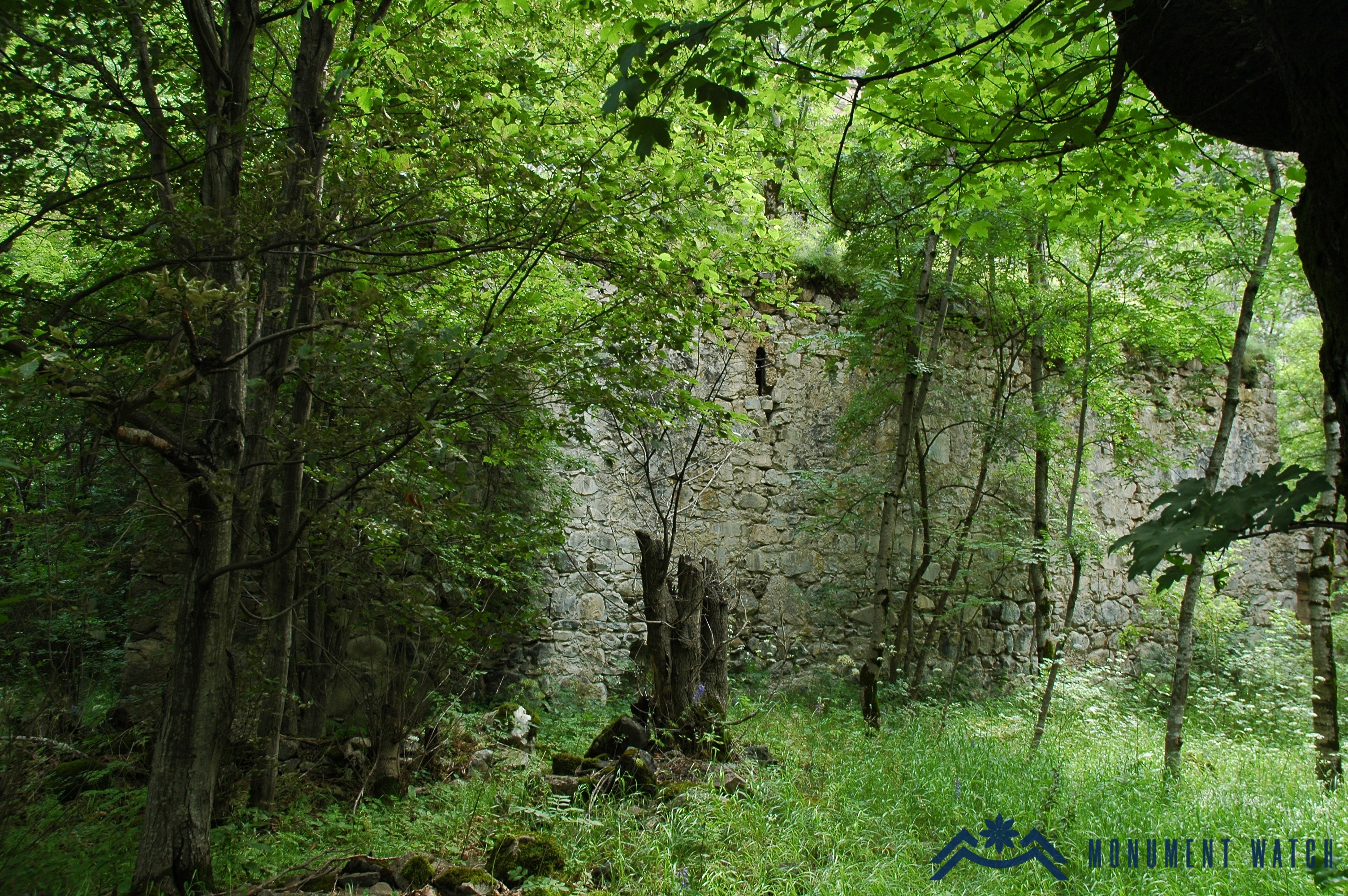The Kusanats Surb Astvatsatsin Hermitage (Anapat)
Location
The hermitage of Kusanats SurbAstvatsatsin lies in the New Shahumian region of the Republic of Artsakh, on the right bank of the Trytu River, approximately 2.7 km northwest (as the crow flies) from Dadivank Monastery. It occupies the point where the Iridja River joins the Trytu through the narrow Iguadzor gorge (Karapetyan 1999, 76).
Historical Overview
Our knowledge of the complex rests chiefly on its extant stone inscriptions. In the 12th century, it is recorded simply as SurbAstvatsatsin, while 17th-century sources call it Kusanats SurbAstvatsatsin ("Hermitage of the Virgins of the Mother of God") (Karapetyan 2019, 358).
The ensemble comprises two chronologically distinct groups of buildings. According to the construction inscriptions, the monastery was founded by Queen Maman, one of the daughters of King Kyurike II of Matsnaberd (reigned 1145–1170). These founding texts are carved into the fabric of the first group of structures nearest the riverbank. For example, on the western façade of one small church, we read:
"In the year 1174, I—Maman, daughter of King Kyurike—built this church for myself and my parents; remember me at the altar."(Karapetyan 2019, 358)
Field reports from 1987–1989 attest that these inscriptions were then intact; by 1993, however, much had been shattered or removed (Karapetyan 1999, 76; Arutyunyan, Karapetyan & Sargsyan 1989, 82–92). A fragmentary inscription inside the columned narthex of the older tract names the founder explicitly:
"In the Armenian year 1178, I—Queen Maman, daughter of Kyurike—built this church and this hall; may you remember (me) in Christ."(Karapetyan 2019, 359)
Donation inscriptions further illuminate the site's patronage. One reads:
"I, Shatbari, gave four hamadks of land at Havar to the Mother of God…"(Karapetyan 2019, 359)
The unit "hamadk" for measuring land appears only in Artsakh's medieval epigraphy, strictly in contexts of monastic land grants (Petrosyan 1988, 63–64). Additionally, 12th–13th-century graffiti on khachkars, sculpted crosses, and painted visitors' inscriptions on interior plaster survive within the precinct (Karapetyan 2019, 362).
Architectural-compositional examination
The monastery consists of two groups of monuments. The monuments of the first group lie close to the bank of the Trytu River. They are similar and almost isometric churches, built in 1174 and 1178 (Figs. 1, 2).
A columned narthex adjoins one of the churches, to which, on the west, a roofed, semi-ruined chamber is attached (Fig. 3). The monuments are built of unworked and roughly hewn ashlar bonded with lime mortar (Figs. 4, 5). The roofs display striking engineering: the slabs suspended from their eaves rest, in essence, on projecting stone corbels transformed from a wooden structural system (Fig. 6). All the structures are plastered on the inside. Also belonging to the first group, at its southwest edge, stands a separate chapel (Figs. 7, 8).
The second group of the complex lies about ten meters south of the first and consists of a three-nave church, a partially ruined gavit attached to its west, and a chamber adjoining that gavit to the south (Figs. 9-12).
The Condition Before and After the War
Between 1989 and 1993, Azerbaijani forces systematically destroyed and damaged the site's khachkars and inscriptions. By 1993, many of the epigraphs recorded by Samvel Karapetyan in 1987 were found fragmented or missing. In 1982, Soviet-period authorities even attempted to recast the hermitage as a pre-Christian (pagan) site (Karapetyan 1999, 76). Today, the surviving structures stand in an advanced state of decay, urgently requiring structural stabilization and comprehensive archaeological study.
Bibliography
- Arutyunyan, Karapetyan, Sargsyan 1989 - Arutyunyan V., Karapetyan S., Sargsyan N., “The Monastic Complex of Surb Astvatsatsin in the Tsar District,” Bulletin/Review of Social Sciences, No. 7, 82–92.
- Petrosyan 1988 - Petrosyan H., “Hamadik-hamatik: Term or Toponym,” Proceedings of the Institute of Archaeology and Ethnography Young Scholars’ Session, Reports, Yerevan, pp. 63–64.
- Karapetyan 1999 - Karapetyan S., Armenian Cultural Monuments in the Regions Annexed to Soviet Azerbaijan, Yerevan.
- Karapetyan 2019 - Karapetyan S., Mravakanq, Yerevan.
The Kusanats Surb Astvatsatsin Hermitage (Anapat)
Artsakh











